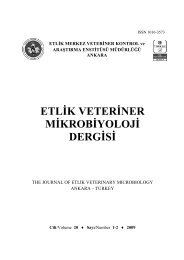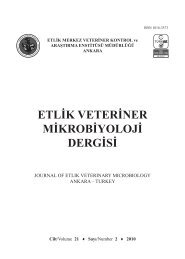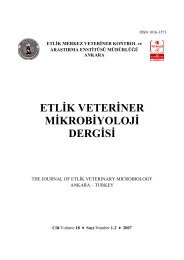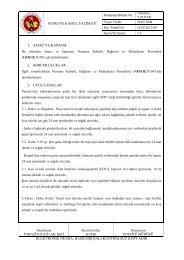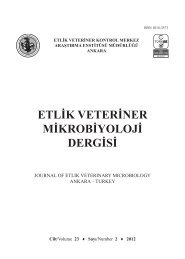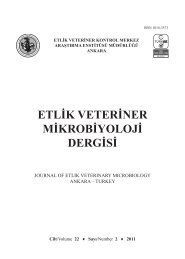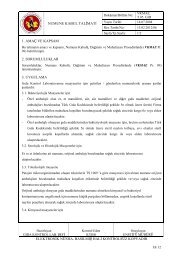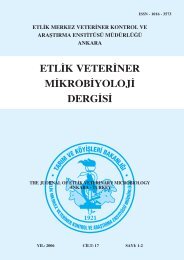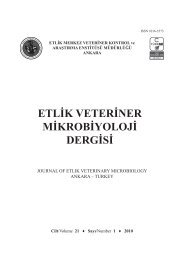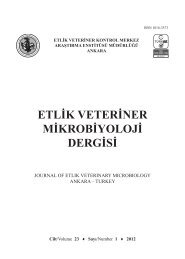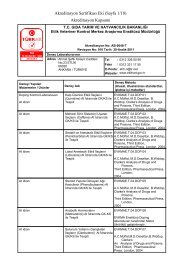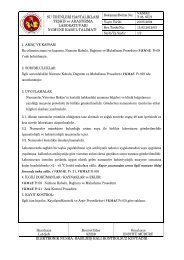Cilt/Volume 19 Sayı/Number 1-2 2008 - veteriner kontrol merkez ...
Cilt/Volume 19 Sayı/Number 1-2 2008 - veteriner kontrol merkez ...
Cilt/Volume 19 Sayı/Number 1-2 2008 - veteriner kontrol merkez ...
Create successful ePaper yourself
Turn your PDF publications into a flip-book with our unique Google optimized e-Paper software.
prevalence of HPAI H5N1 viruses throughout<br />
Turkey in 2006 suggests that viruses may have<br />
spread to different regions by the introduction of<br />
infected wild animals. But It is unknown at present<br />
whether HPAI H5N1 infection will persist in wild<br />
bird populations throughout the year in the absence<br />
of further introductions. For this reason,<br />
epidemiological studies are required in Turkey in<br />
the areas where infection has been found in wild<br />
birds to identify the domestic poultry flocks that<br />
could be regarded as at risk.<br />
As a result, this study provides a<br />
characterization of recent HPAI H5N1 viruses<br />
isolated from Turkey that caused between 2005 and<br />
<strong>2008</strong>, which has a relationship with HPAI H5N1<br />
outbreak in neighboring countries. To avoid future<br />
outbreaks, we need a clear understanding of how<br />
this unprecedented epidemic began. Therefore,<br />
further characterization of the HPAI H5N1 viruses<br />
is urgently needed.<br />
Acknowledgements<br />
This study was requested by The General<br />
Directorate of Protection and Control of The<br />
Ministry of Agriculture and Rural Affairs. I would<br />
like to thank to the Poultry Disease Diagnosis<br />
Laboratories of Etlik Central, Bornova İzmir and<br />
Pendik İstanbul Veterinary Control and Research<br />
Institues for providing me all samples.<br />
References<br />
1. Brown I, (2006). Incursion of H5N1 ‘Asian lineage’ virus<br />
into Europe: source of introduction?, International<br />
Scientific Conference on Avian Influenza and Wild Birds,<br />
May 30-31, Rome-Italy.<br />
2. Brown I, Londt BZ, Shell W, Manvel RJ, Banks J,<br />
Gardner R, Outtrim L, Essen SC, Sabirovic M,<br />
Etlik Veteriner Mikrobiyoloji Derg, <strong>19</strong>, <strong>2008</strong> 37<br />
Slomka, M, Alexander DJ, (2006). First incursion of<br />
H5N1 highly pathogenic avian influenza viruses of the<br />
‘Asia’ lineage into Europe. 6th International Symposium<br />
on Avian Influenza, Session 9. Late Breaking Issues, St<br />
John’s College, April 3-6, Cambridge-UK.<br />
3. CLC, (2007). Genetic characterization of highly<br />
pathogenic H5N1 avian influenza A viruses, Case Study,<br />
CLC Bio Official Circular, Gustav Wieds Vej 10 8000,<br />
October 5, Aarhus C Denmark.<br />
4. Lin Y, (2007). WHO Influenza Centre, National Institute<br />
for Medical Research, The Ridgeway Mill Hill, London<br />
NW7 1AA, UK.<br />
5. Lipatov AS, EvseenkoVA, Yen HL, Zaykovskaya AV,<br />
Durimanov AG, Zolotykh SI, Netesov SV, Drozdov IG,<br />
Onishchenko GG, Webster RG and Shestopalov AM,<br />
(2007). Influenza (H5N1) Viruses in Poultry, Russian<br />
Federation, 2005-2006, Emerging Infect Dis 13, 539-546.<br />
6. OIE, (<strong>2008</strong>). Avian Influenza, Manual of Diagnostic Tests<br />
and Vaccines for Terrestrial Animals, Chapter 2.3.4.,<br />
p.465-481.<br />
7. Owoade AA, Gerloff NA, Ducatez MF, Taiwo JO,<br />
Kremer JR and Muller CP, (<strong>2008</strong>). Replacement of<br />
Sublineages of Avian Influenza (H5N1) by Reassortments,<br />
Sub-Saharan Africa, Emerg Infect Dis 14 (11), 1731-1735.<br />
8. Sabirovic M, Wilesmith J, Hall S, Coulson N, Landeg F,<br />
(2006). Outbreaks of HPAI H5N1 virus in Europe during<br />
2005/2006 - An overview and commentary, International<br />
Animal Health Division, 1A Page Street, London, SW1P<br />
4PQ, United Kingdom., Defra, Situation Analysis Version<br />
1, Released June 30, pp. 40.<br />
9. Turcitu MA, Coste HC, Cioranu RP, Nicolae S, Barboi<br />
G, Onita I, Neagoe G and Neicut A, (2006). HPAI<br />
circulating among Romania, Romania.<br />
10. Yingst SL, Saad MD and Felt SA, (2006). Qinghai-like<br />
H5N1 from Domestic Cats, Northern Iraq Emerging Infect<br />
Dis 12 (8), 1295-1297.<br />
11. WHO, (2006). Epidemiology of WHO-confirmed human<br />
cases of avian influenza A(H5N1) infection, Weekly<br />
epidemiological record, No. 26 (81), 249–260.



